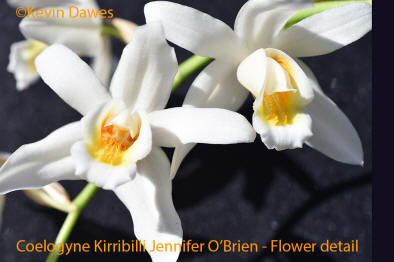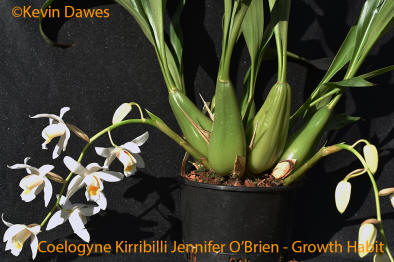This secondary hybrid was created using one of the best known, large, upright white species, Coelogyne mooreana 'Brockhurst' as a pod parent. The pollen parent, a primary hybrid, Coelogyne Unchained Melody, is a popular pendulous plant. The particular plant used in this case was a much whiter variety that has been associated with a lot of background controversy and was often sold in Australia as Coelogyne mossiae. It is more generally recognised now as Coelogyne Unchained Melody 'Alba' even though it is not totally white but has a very pale lemon colouring in the throat.
I pollinated this hybrid 26.07.2008 and flasked it on 26.04.2009. For these pods to reach maturity at only nine months is a little quicker than usual for a Coelogyne pod. The protocorms then took longer than usual to reach deflasking stage on 4.10.2010. The seedlings were strong and healthy but took another seven years to grow into strong and healthy plants before flowering for the first time on 26.08.2017.
Coelogyne mooreana has a very strong influence on all its matings and this hybrid was no exception. It has modified the pendulous nature of the pollen parent to seven flowers on a downward arching spike that terminates at a level about the bottom of the pot.
The flowers are very open and present well. The petals are only marginally narrower than the 2cm wide sepals, giving the flower a squarish, robust presentation. The petals have a slight hint of waviness, possibly from its Coelogyne cristata ancestor. They are slightly reflexed and the dorsal sepal leans forward slightly.
Coelogyne mooreana has also dominated the keel formation. These are numerous, long and extend from the throat to the outer lobes. The well defined keel structure of Coelogyne flaccida has been suppressed but there is a tiny hint of darker colouring on the lip end of the more central keels. The column is large, creamy white on the outside with a yellow longitudinal line on the underside.
The overall colour of the flower is a rich, creamy white. The throat has a rich, pure lemon colouring that extends well up the inside lobes and is accentuated by rich orange on the keel tips. There is a tiny hint of the dark veins on the inside lobes as in Coelogyne flaccida. On the outside of the lip at the end of the mid-lobe are hints of yellow colouring that have seeped through from the throat as is often the case with Coelogyne mooreana. There is a very slight perfume at times.
The psuedobulbs are large, 12cm high and 5cm wide at the base and tapering noticeably to the tip. They are deeply ridged with four main grooves.
The inflorescences are proteranthous, coming from the base of the mature growths. This trait is inherited from Coelogyne Unchained Melody and is quite distinct form Coelogyne mooreana whose spikes emerge from the apex of developed psuedobulbs.
This hybrid has been named in honour of my loving sister-in-law who has been part of a very close knit family and a great environmentalist/gardener. A very enthusiastic Australian plant supporter, she has worked with her husband to revegetate many hectares of farm land with original species.
Negatives: .This Coelogyne, like most of its kind, needs a moist environment and dappled light with an absence of frost .
Rating: ♦♦♦♦ This is yet another absolutely beautiful Coelogyne mooreana based hybrid that would be a delight to own but will unfortunately find it difficult to compete with the free availability of its beautiful parents.
Registration: Registration with the RHS as Coelogyne Kirribilli Jennifer O'Brien was recorded in September 2017.
Varieties: None known.
Hybrids: None registered
| < Coel Kirribilli Janet Dixon-Smith | Coel Kirribilli Jimmy > |

